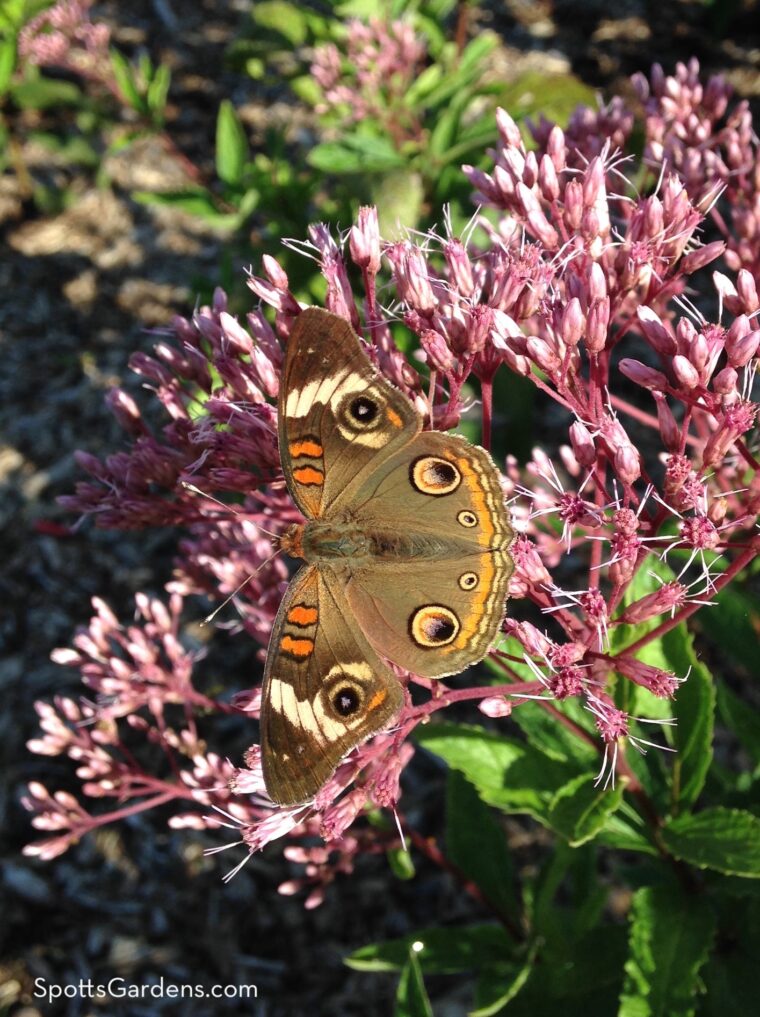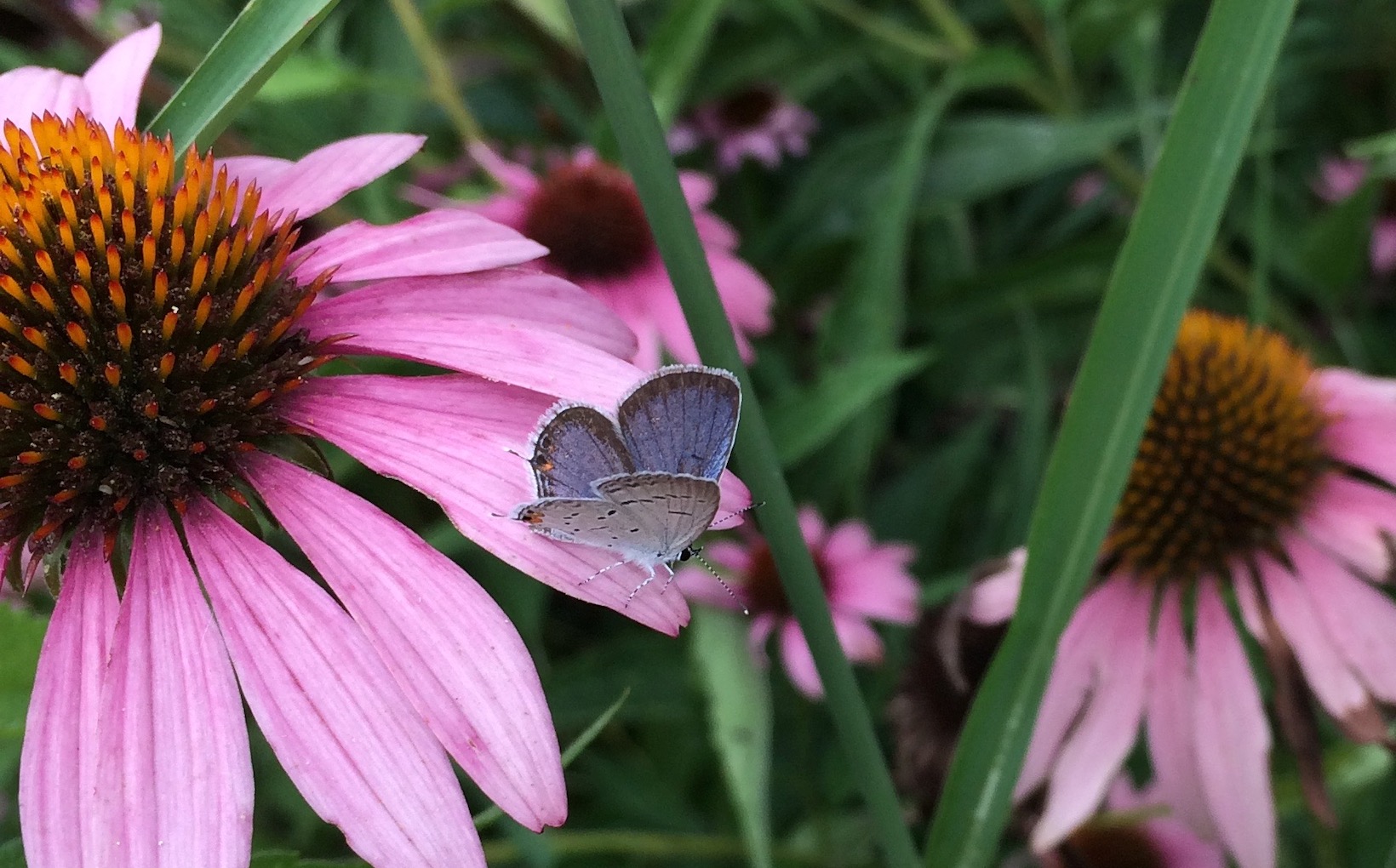As you plan your garden, consider ways to make it a haven for bees, butterflies, and other pollinators.
Why plant for pollinators?
Nearly 1 in 3 bites of food we eat are directly attributable to pollinators! And pollinators are a vital species in most land ecosystems. More than 85 percent of the world’s flowering plants rely on pollinators for reproduction.
Our native pollinators are facing extreme threats. The U.S. is home to more than 3500 species of native bees, but many have experienced catastrophic decline. According to Xerces Society for Invertebrate Conservation research, more than one-quarter of American bumble bee species face some degree of extinction risk. And 19% of U.S. butterfly species are now at risk of extinction!
What can you do to help reverse the decline?

1. Stop using pesticides
The use of herbicides has destroyed habitat around cultivated land, killing the wildflower and weedy areas that used to feed pollinators. Herbicides can also leave traces in the pollen that bees eat.
Pesticides and herbicides may kill bees directly. They can also have a sub-lethal effect that reduces the number of offspring they can produce. Even organic pesticides can have an adverse effect, wiping out the next generation of pollinators and beneficial insects.
Instead, focus on creating a healthy, organic garden with sustainable techniques. Choose plants that are appropriate for the light and moisture levels in your garden. Manage weeds with hand weeding and mulch. Remove pest insects by using hand picking and row covers. Pesticide-free gardens also welcome beneficial insects that can help manage insect pest populations.
2. Plant for pollinators
To feed pollinators, plant a diverse range of flowering plants to provide both nectar and pollen. Use a mix of trees, shrubs, perennials, and annuals so that bloom times overlap. Aim to have at least three species in bloom at all times from very early spring to very late fall.
Bees exhibit “flower fidelity,” which means they prefer to forage one kind of flower at a time. Make it easy for them by planting in groups of single species. Mix swathes of different flower shapes in the same border.
Build your pollinator garden around native plants, which are four times as attractive to our native bees as exotic plants are.
Native Plants For Pollinators
Based on recommendations from the Xerces Society for Invertebrate Conservation, these native Indiana perennials are excellent for pollinators. We find the plants on this list to be well-behaved enough for residential gardens. If you’re using cultivars (named varieties of these plants), use those that are as close to the wild form as possible.
- Asclepias tuberosa (butterfly weed)
- Asclepias incarnata (swamp milkweed)
- Baptisia australis (False indigo)
- Echinacea purpurea (Coneflower)
- Eutrochium maculatum (Spotted Joe Pye weed)
- Eutrochium purpureum (Joe Pye weed)
- Geranium maculatum (Wild geranium)
- Helenium autumnale (Sneezeweed)
- Liatris pycnostachya (Prairie blazing star)
- Liatris spicata (Blazing star; gayfeather)
- Monarda fistulosa (Bee balm)
- Penstemon digitalis (Beardtongue)
- Solidago speciosa (Showy goldenrod)
- Symphotrichum laeve (Smooth aster)
- Symphotrichum novae-angliae (New England aster)
- Tradescantia ohioensis (Ohio spiderwort)
You can supplement these native herbaceous plants with bee-friendly non-natives like borage, cosmos, mint, and the Mediterranean herbs (rosemary, lavender, sage, thyme, and oregano).
Native trees and shrubs that are particularly good for pollinators include:
- Amelanchier arborea (Downy serviceberry)
- Amelanchier laevis (Allegheny serviceberry)
- Cephalanthus occidentalis (Button bush)
- Cercis canadensis (Eastern redbud)
- Crataegus crus-galli (Cockspur hawthorne, tree)
- Liriodendron tulipifera (Tulip tree)
- Nyssa sylvatica (Tupelo)
- Tilia americana (Basswood)
See Purdue University Cooperative Extension Service’s complete list.

3. Create habitat
The majority of our native bees are solitary bees rather than social ones like honey bees. These native bees make their nests in piles of sticks, rotted out stumps, and bits of bare earth.
To provide habitat, leave your garden a little bit messy. Leave spots of bare, unmulched soil to encourage ground-nesting bees. Plant host plants for butterfly larvae. Leave a brush pile or a small bundle of sticks tucked in the back of the border.
Be smart about cleaning up the garden, too. Leave plants standing over winter to provide shelter for hibernating insects.
Create a Pollinator Haven
Start now! Check out the great resources at The Xerces Society for Invertebrate Conservation, and then get planting. Together we can Bring Back the Pollinators!
Want to make your garden more pollinator friendly? We can help! Contact us for a garden visit today.

